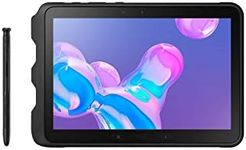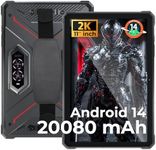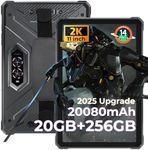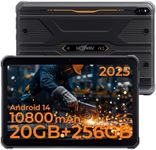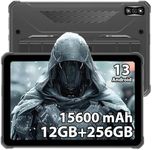Buying Guide for the Best Waterproof Tablets
Choosing a waterproof tablet can be a smart move if you plan to use your device near water, outdoors, or in environments where spills and splashes are common. The right waterproof tablet will give you peace of mind and allow you to use your device in more places without worrying about damage. To find the best fit, it's important to understand the key features that make a tablet both functional and durable in wet conditions.Waterproof Rating (IP Rating)The waterproof rating, often shown as an IP (Ingress Protection) code, tells you how well the tablet is protected against water and dust. The first number after 'IP' refers to dust protection, and the second to water. For example, IP67 means the device is dust-tight and can handle being submerged in water up to 1 meter for 30 minutes. IP68 offers even more protection, often allowing for deeper or longer submersion. If you plan to use your tablet near pools, in the rain, or at the beach, look for at least IP67. For heavy-duty outdoor or underwater use, IP68 is better. If you only need splash resistance, a lower rating may be enough.
Screen DurabilityScreen durability refers to how well the tablet's display can withstand drops, scratches, and impacts. Waterproof tablets often come with reinforced glass, like Gorilla Glass, to prevent cracks and scratches. If you expect to use your tablet in rugged environments or around children, a tougher screen is important. For mostly indoor or gentle use, standard durability may suffice, but for outdoor adventures or work sites, look for tablets that highlight extra-strong screens.
Port and Button SealingPort and button sealing means that all openings, like charging ports and headphone jacks, are protected against water entry. Some tablets use flaps or special coatings to keep water out. If you need to use ports frequently, check how easy it is to open and close these seals. For maximum protection, choose a tablet with well-designed, easy-to-use seals, especially if you expect to use the device in wet or dirty conditions.
Battery LifeBattery life is how long the tablet can run on a single charge. Waterproof tablets are often used outdoors or away from power sources, so longer battery life is important. Tablets with larger batteries can last all day or more, while smaller batteries may need more frequent charging. If you plan to use your tablet for long hikes, travel, or work shifts, prioritize longer battery life. For short, casual use, standard battery life may be enough.
Weight and PortabilityWeight and portability refer to how easy it is to carry the tablet around. Waterproof tablets can sometimes be heavier due to extra protection. If you need a device for travel, hiking, or carrying in a bag, look for a lighter, more compact model. If the tablet will mostly stay in one place, weight may be less important.
Touchscreen Responsiveness When WetTouchscreen responsiveness when wet is how well the tablet's screen works if your hands or the screen are damp. Some waterproof tablets are designed to recognize touch even when wet, while others may struggle. If you expect to use the tablet in the rain, by the pool, or with wet hands, look for models that mention good wet-touch performance.
